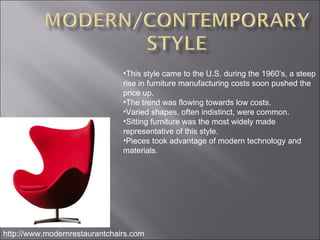Interior Design Furniture Style
- 1. http://www.modernrestaurantchairs.com This style came to the U.S. during the 1960ŌĆÖs, a steep rise in furniture manufacturing costs soon pushed the price up. The trend was flowing towards low costs. Varied shapes, often indistinct, were common. Sitting furniture was the most widely made representative of this style. Pieces took advantage of modern technology and materials.
- 2. http://www.fineartchairs.com/ Often described as a revolt against the historical revival styles. Was influenced by the tastes that made up the Arts and Crafts style Overall appearance was elongated and flowing. Elaborate carvings and inlays were typical.
- 3. http://www.fromoldbooks.org Queen Anne style was named after EnglandŌĆÖs queen from 1702 to 1714. The StyleŌĆÖs most important development is the cabriole leg. Surfaces were often polished and sometimes had carvings. Pieces were small and delicate. The style was created to incorporate to colonists of that time periods needs.
- 4. http://www.victorhallantiques.com In 1754 Thomas Chippendale, an English cabinetmaker and furniture designer, published a book that made his designs popular at the time. Greatly influenced by American furniture makers. Appearance is graceful and flowing, with curving lines and delicate proportions.
- 5. http://www.nysm.nysed.gov/treasures This particular style came to existence after the American Revolution. It is influenced by the people wanting to show independence and ideals following the war. They named it after their new type of government. Appearance is slender an delicate. With classic lines inspired by ancient Greed and Roman forms. Geometric shapes were evident.
- 6. http://www.efi-costarica.com Developed in Paris around the turn of the 18 th century, the Empire style was the official style of the Napoleonic Empire. The style often incorporated Egyptian motifs to mark NapoleonŌĆÖs campaigns in Egypt. The American version of the style became popular in the U.S. between 1815 and 1820. Appearance was massive and bulky, with sharp corners, heavy bases, and unbroken flat surfaces.
- 7. http://teak-outdoor-furniture123.com Some of the most original American furniture designs came from the Shaker religious sect. Shaker pieces were extremely well made. Structure often included straight lines and simple geometric shapes.
- 8. http://www.laurelauction.com The development of the American Fed. style relied heavily of the design books of two English furniture designers, one being George Hepplewhite. Style generally adhered to straight structural lines. Pieces usually had squared tapered legs. Extensive veneering was used.
- 9. http://images.oneofakindantiques.com It is named after American cabinetmaker Duncan Phyfe, and is considered by some art historians as more of an adaptation and refinement of Adam, Sheraton, Hepplewhite and Empire than a style in itself. The Duncan Phyfe style is characterized by carved or reeded legs and neoclassic motifs http://www.connectedlines.com
- 10. http://www.egyptian-french-furniture-reproductions.com/ Between the 17th and early 18th century, Baroque style heavily influenced Western Europe. It originated in Italy and was representative of the Roman Catholic Church. Pieces are characterized by large twisted columns, broken pediments, and heavy moldings. The details are related to the entire piece and flow throughout the entire work rather than simply throughout one panel. http://www.restorations.net
- 11. http://www.auctionflex.com/auctionimages Around 17 th century the Spanish style of Baroque became more popular. Many beige colors were used. Along with wood with decorative legs and arm rests










